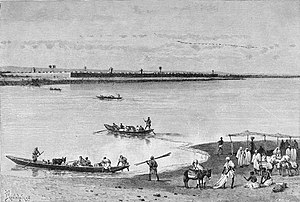| Logone-Birni Logone, Lagone | |
|---|---|
 Logone-Birni, 1892 Logone-Birni, 1892 | |
 | |
| Coordinates: 11°46′50″N 15°06′15″E / 11.78056°N 15.10417°E / 11.78056; 15.10417 | |
| Country | |
| Province | Far North Province |
| Division | Logone-et-Chari |
| Population | |
| • Ethnicities | Kotoko |
| • Religions | Islam |
Logone-Birni is a town and commune in Cameroon. The town lies on the left (west) bank of the Logone River which at this point forms the state boundary between Cameroon and Chad. It is the capital of the Kotoko people, whose two other principal cities are Kousséri and Goulfey.
History
Logone-Birne means Fort Logone and was founded around 1700 by Prince Bruha. Dixon Denham visited Logone on 23 January 1824. He reported:
- "I rode down to the river, which here flows with great beauty and majesty past the high walls of this capital of Loggun; it comes direct from the south-west, with a rapid current. We entered the town by the western gate, which leads to the principal street: it is as wide as Pall Mall and has large dwellings on each side, built with great uniformity, each having a courtyard in front, surrounded by a wall, and a handsome entrance, with a strong door hasped with iron: a number of the inhabitants were seated at their doors for the purpose of seeing us enter, with their slaves ranged behind them".
Gannibal
Logone-Birni has been suggested as the birthplace of Abram Petrovich Gannibal (1696-1781), a General in the Imperial Russian Army and great-grandfather of Alexander Pushkin. This view was first aired by Vladimir Nabokov in 1962, albeit in a dismissive remark. Previously, the predominant view, was that Gannibal was from Ethiopia. As Hugh Barnes suggested this may have arisen from the generic use of the term "Ethiopian" to cover all of Africa. However, in 1996 Dieudonné Gnammankou convincingly argued that Logone-Birni was his birthplace. This view was further elaborated by Hugh Barnes in Gannibal: The Moor of Petersburg (2005).
Geography
The Logone Birni Basin
Logone-Birni has given its name to the Logone Birni Basin, which covers an area of 27,000 km2 and is part of the West and Central African Rift System.
See also
References
- ^ Barnes, Hugh (2005). Gannibal : the moor of Petersburg. London: Profile Books. ISBN 9781861973658.
- Denham, Dixon; Clapperton, Hugh; Oudney, Walter (1826). Narrative of travels and discoveries in Northern and Central Africa: in the years 1822, 1823, and 1824 (2 Volumes). London: Murray. Volume 2 p 14
- Nabokov, Vladimir (1962). "Pushkin and Gannibal". Encounter. 19 (1): 11–26.
- Catharine Theimer Nepomnyashchy, Nicole Svobodny, Ludmilla A. Trigos (eds.) (2006). Under the Sky of My Africa: Alexander Pushkin and Blackness. Northwestern University Press. p. 31. ISBN 0810119714. Retrieved 7 January 2015.
{{cite book}}:|last1=has generic name (help)CS1 maint: multiple names: authors list (link) - New Statesman. New Statesman. 2005. p. 36. Retrieved 7 January 2015.
- Loule, Jean-Pierre; Lumbomil, Pospisil. "The Logone Birni Basin (LLB) in Northern Cameroon: Transition Between the West African Rift Sub- System (WAS) and the Central African Rift Sub-System (CAS); Tectonic and Geophysical Models". AAPG Search and Discovery. AAPG. Retrieved 31 January 2016.
- Site de la primature - Élections municipales 2002 (in French)
- Contrôle de gestion et performance des services publics communaux des villes camerounaises - Thèse de Donation Avele, Université Montesquieu Bordeaux IV (in French)
- Charles Nanga, La réforme de l’administration territoriale au Cameroun à la lumière de la loi constitutionnelle n° 96/06 du 18 janvier 1996, Mémoire ENA. (in French)
| Communes of Far North Region, Cameroon | ||
|---|---|---|
| Diamaré |  | |
| Logone-et-Chari | ||
| Mayo-Danay | ||
| Mayo-Kani | ||
| Mayo-Sava | ||
| Mayo-Tsanaga | ||
This Cameroon location article is a stub. You can help Misplaced Pages by expanding it. |